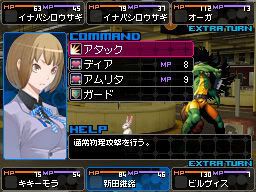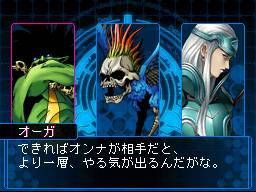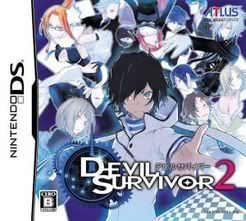Before this blog dies due to my... life, I thought I should ignore thematic restrictions I've more or less set myself and post anything I do recently, which in this case was finishing Devil Survivor 2. My fondness for reviewing prevails in any area though, so I'll try to actually rate this properly for those looking forward to the western release next year.
Devil Survivor (DS from here on) has (hopefully?) become another series entry in the huge megaten franchise by now so I'll also be comparing part 2 with part 1 but try to avoid any major/detailed spoilers. Not that the game's opening would not be spoilerific enough anyway...

For those new to the series:
DS combines classical role-playing combat similar to other entries in the franchise with strategic field combat. I cannot really rate the latter since the only serious contact I made with that subgenre were Final Fantasy Tactics and FFT Advance, but I guess the field combat part is rather simple in comparison to other games. You have a set number of squares you can move per turn that varies depending on which demons you equipped (later more on demons) and once you are in the enemies range you can select to attack him and you can also use abilities on the field like healing or slowing down the enemies. Once you attack an enemy you switch into really traditional combat view and select normal attacks or specific skills. Each character (up to 4 in battle) can equip 2 demons who can do the same; the enemy team consists of a similar formation or just 3 demons. After combat you return to the field and heal or end your turn.

Demons essentially are your enemies, but due to a special device you can also buy them, fuse new demons by combining 2 of them or simply summon them for money once you bought or created them for the first time. Their abilities depend on how you fused them and which fusing add-ons you used, but they always have one special unchangable skill relating to their race. The characters' skills are fully customizable, but as with your demons you can only equip 3 attacking skills and 3 automatic/defense skills that guard, heal, fasten you and so on. Once you cracked skills from enemy demons by selecting those and defeating them with the according character's team, you can equip any character with these skills as long as his parameters suffice. Parameters are divided automatically on level-ups, except for the nameless main character where you can allign them yourself.

As for the remaining gameplay, it plays out almost like a visual novel. You see a map and you can select various events that lead to dialogues with the characters where you have to make certain choices in answering them. These choices can highly influence the story's progess and outcome, as in DS characters can ultimately die and near the end of the game the player chooses between different ending routes that show different aspects and turns of the plot.
An innovation in DS2 is that you can actually see the progress you made with each character by looking at his Enishi rank. This rank ranges from 1 to 5 and you gain things from each rank-up like the sharing of skill crackings and unlocking of specific demons. Furthermore you must actually have them at least on rank 4 or otherwise you can't recruit them again on your finite ending route later on depending on which route you chose.
The plot in DS2 starts out with your 3 more or less main characters in Tokyo after their enrollment tests. Uncertain about their future, they soon have to witness a much more threatening view: The recently popular internet site "Nicaea" shows users their dying scene and actually keeps its premise. Your characters barely survive an earthquake and a derailing subway train, just to be suddenly confronted with demons. Nicaea also offers a demon tamer device though and they manage to survive those as well after fighting them. However the students witness a perishing Tokyo and frequent attacks from monsters much more powerful than the demons. As the story unravels you get to know other demon tamers and finally find out about those monsters called Septentrion, their purpose and where they are coming from.

In comparison to part 1 with its Tokyo lockdown, DS2 also features Osaka and Nagoya and portrays not only the destruction of Japan but the whole world. The grand scale was definitely welcomed so that DS2 can actually differ enough from its predecessor, however this also brought forth a signicificant distinction when you compare this entry with other megaten games: The world of the demons plays a rather simple role here as demons are really only used in combat and nothing more, while heaven with god and his angels does not appear at all. This is not a bad thing per se, but it also makes for inevitable shifts in plot structure. Your main thread are (omg spoiler... not) extraterrestrial-ish entities and you don't have to decide whether you align with the devil or god, so the ending routes are not that extremely denoted by values and opinions. It's still very much comparable to DS and megaten in general, don't get me wrong, the difference is that conflicts are solely portrayed and developed among the humans. For some this might be a welcome change, for others not so much. I guess it's a totally subjective matter.
As for me, I'm pretty much fine with both ideas, but I have to say that some later events and turns in the game are a little bit on the shallow side. I mean, there is an ending route where you can almost re-recruit every single character regardless of their contrasting opinions just by persuading them as long as your Enishi rank is high enough. With some characters this ended on the verge of disbelief for me, but this is only my personal perception and sentiment. The only aspect that kind of bugs me is that the game practically beckons you to do a certain route because you get the most points after clearing the game.
Despite all of that, the routes and outlooks were different enough considering it's just about humans and how they deal with their imminent demise and the prompt to decide their ethos. This was mostly handled pretty well, as most of the characters have a clear motivation and background, even if they might not be the most outstanding characters in the franchise. The sheer number of characters and amount of dialogue certainly makes up for that and while the plot might not be as overwhelming as DS1 and despite the imminent world destruction scenario funnily not as much tension is evoked, DS2 was one of the most fun RPGs I've played in the last few years. The gameplay is much more fluent and less tedious at some points (big YAY for shared skill cracking), the Septentrion battles actually show some innovative combat conditions and stuff is constantly happening. I never felt bored and always felt the urge to continue. Heck, this is one of the few games where I actually consider a second run.
The music also significantly improved, as Ito Kenji and the Atlus Sound Team simply know more about actual video game compositions and the soundtrack sounds neat both in the game and on CD, similar to better Nintendo DS OSTs like those of Sigma Harmonics or Soma Bringer. In DS1 I somehow felt that Asano Takami certainly was the member of a rock band that started in the friggin' 70s. His tracks rely heavily on wailing guitars which IMO sometimes was just overwhelming for a strategy RPG. Just compare his normal battle theme with the one by Atlus. Much more pleasant when you actually have to concentrate, even if just for a short time. Furthermore Ito Kenji provides for epic battle field music like this!
Graphics also somewhat improved, at least the Septentrion battles are an improvement and there are more CG scenes this time.
Overall I can only recommend this to anyone not totally disgusted by strategy RPGs, as I also don't play these usually. Plot and characters are satisfactory if not fine considering most of them have distinct backgrounds and developments. I played this for somewhat around 50 hours according to my savestate but counting in the auctions and fusions I'd definitely say 60 or more and there are 5 ending routes to explore and extra bosses on the second run so this handheld RPG is not inferior to those on the consoles in terms of playing time and replay value.
Summary:
+ more focus on more likeable characters
+ slight but welcome gameplay improvements
+ more and better music
- characters almost too likeable (slight suspension of disbelief sometimes)
- ending routes don't differ as significantly as in the predecessor
- kind of shoots its wad a tad too early, not many revelations near the end
Overall Rating: 87%

For those new to the series:
DS combines classical role-playing combat similar to other entries in the franchise with strategic field combat. I cannot really rate the latter since the only serious contact I made with that subgenre were Final Fantasy Tactics and FFT Advance, but I guess the field combat part is rather simple in comparison to other games. You have a set number of squares you can move per turn that varies depending on which demons you equipped (later more on demons) and once you are in the enemies range you can select to attack him and you can also use abilities on the field like healing or slowing down the enemies. Once you attack an enemy you switch into really traditional combat view and select normal attacks or specific skills. Each character (up to 4 in battle) can equip 2 demons who can do the same; the enemy team consists of a similar formation or just 3 demons. After combat you return to the field and heal or end your turn.

Demons essentially are your enemies, but due to a special device you can also buy them, fuse new demons by combining 2 of them or simply summon them for money once you bought or created them for the first time. Their abilities depend on how you fused them and which fusing add-ons you used, but they always have one special unchangable skill relating to their race. The characters' skills are fully customizable, but as with your demons you can only equip 3 attacking skills and 3 automatic/defense skills that guard, heal, fasten you and so on. Once you cracked skills from enemy demons by selecting those and defeating them with the according character's team, you can equip any character with these skills as long as his parameters suffice. Parameters are divided automatically on level-ups, except for the nameless main character where you can allign them yourself.

As for the remaining gameplay, it plays out almost like a visual novel. You see a map and you can select various events that lead to dialogues with the characters where you have to make certain choices in answering them. These choices can highly influence the story's progess and outcome, as in DS characters can ultimately die and near the end of the game the player chooses between different ending routes that show different aspects and turns of the plot.
An innovation in DS2 is that you can actually see the progress you made with each character by looking at his Enishi rank. This rank ranges from 1 to 5 and you gain things from each rank-up like the sharing of skill crackings and unlocking of specific demons. Furthermore you must actually have them at least on rank 4 or otherwise you can't recruit them again on your finite ending route later on depending on which route you chose.
The plot in DS2 starts out with your 3 more or less main characters in Tokyo after their enrollment tests. Uncertain about their future, they soon have to witness a much more threatening view: The recently popular internet site "Nicaea" shows users their dying scene and actually keeps its premise. Your characters barely survive an earthquake and a derailing subway train, just to be suddenly confronted with demons. Nicaea also offers a demon tamer device though and they manage to survive those as well after fighting them. However the students witness a perishing Tokyo and frequent attacks from monsters much more powerful than the demons. As the story unravels you get to know other demon tamers and finally find out about those monsters called Septentrion, their purpose and where they are coming from.

In comparison to part 1 with its Tokyo lockdown, DS2 also features Osaka and Nagoya and portrays not only the destruction of Japan but the whole world. The grand scale was definitely welcomed so that DS2 can actually differ enough from its predecessor, however this also brought forth a signicificant distinction when you compare this entry with other megaten games: The world of the demons plays a rather simple role here as demons are really only used in combat and nothing more, while heaven with god and his angels does not appear at all. This is not a bad thing per se, but it also makes for inevitable shifts in plot structure. Your main thread are (omg spoiler... not) extraterrestrial-ish entities and you don't have to decide whether you align with the devil or god, so the ending routes are not that extremely denoted by values and opinions. It's still very much comparable to DS and megaten in general, don't get me wrong, the difference is that conflicts are solely portrayed and developed among the humans. For some this might be a welcome change, for others not so much. I guess it's a totally subjective matter.
As for me, I'm pretty much fine with both ideas, but I have to say that some later events and turns in the game are a little bit on the shallow side. I mean, there is an ending route where you can almost re-recruit every single character regardless of their contrasting opinions just by persuading them as long as your Enishi rank is high enough. With some characters this ended on the verge of disbelief for me, but this is only my personal perception and sentiment. The only aspect that kind of bugs me is that the game practically beckons you to do a certain route because you get the most points after clearing the game.
Despite all of that, the routes and outlooks were different enough considering it's just about humans and how they deal with their imminent demise and the prompt to decide their ethos. This was mostly handled pretty well, as most of the characters have a clear motivation and background, even if they might not be the most outstanding characters in the franchise. The sheer number of characters and amount of dialogue certainly makes up for that and while the plot might not be as overwhelming as DS1 and despite the imminent world destruction scenario funnily not as much tension is evoked, DS2 was one of the most fun RPGs I've played in the last few years. The gameplay is much more fluent and less tedious at some points (big YAY for shared skill cracking), the Septentrion battles actually show some innovative combat conditions and stuff is constantly happening. I never felt bored and always felt the urge to continue. Heck, this is one of the few games where I actually consider a second run.
The music also significantly improved, as Ito Kenji and the Atlus Sound Team simply know more about actual video game compositions and the soundtrack sounds neat both in the game and on CD, similar to better Nintendo DS OSTs like those of Sigma Harmonics or Soma Bringer. In DS1 I somehow felt that Asano Takami certainly was the member of a rock band that started in the friggin' 70s. His tracks rely heavily on wailing guitars which IMO sometimes was just overwhelming for a strategy RPG. Just compare his normal battle theme with the one by Atlus. Much more pleasant when you actually have to concentrate, even if just for a short time. Furthermore Ito Kenji provides for epic battle field music like this!
Graphics also somewhat improved, at least the Septentrion battles are an improvement and there are more CG scenes this time.
Overall I can only recommend this to anyone not totally disgusted by strategy RPGs, as I also don't play these usually. Plot and characters are satisfactory if not fine considering most of them have distinct backgrounds and developments. I played this for somewhat around 50 hours according to my savestate but counting in the auctions and fusions I'd definitely say 60 or more and there are 5 ending routes to explore and extra bosses on the second run so this handheld RPG is not inferior to those on the consoles in terms of playing time and replay value.
Summary:
+ more focus on more likeable characters
+ slight but welcome gameplay improvements
+ more and better music
- characters almost too likeable (slight suspension of disbelief sometimes)
- ending routes don't differ as significantly as in the predecessor
- kind of shoots its wad a tad too early, not many revelations near the end
Overall Rating: 87%





I think it's funny to see how different this review is from your usual reviews: it's a lot longer than your book reviews, it includes a grade and a bullet point summary. Yes, a lot of game reviews work like this, but it seems so different from your usual M.O. :P
ReplyDeleteNever played a Megaten btw, but that's kinda because I'm not a fan of dungeon crawling RPGs and SRPGs (well, I like them, but I'm bad at them ~_~).
Ah, this reminds me I should continue with 999 (DS)...